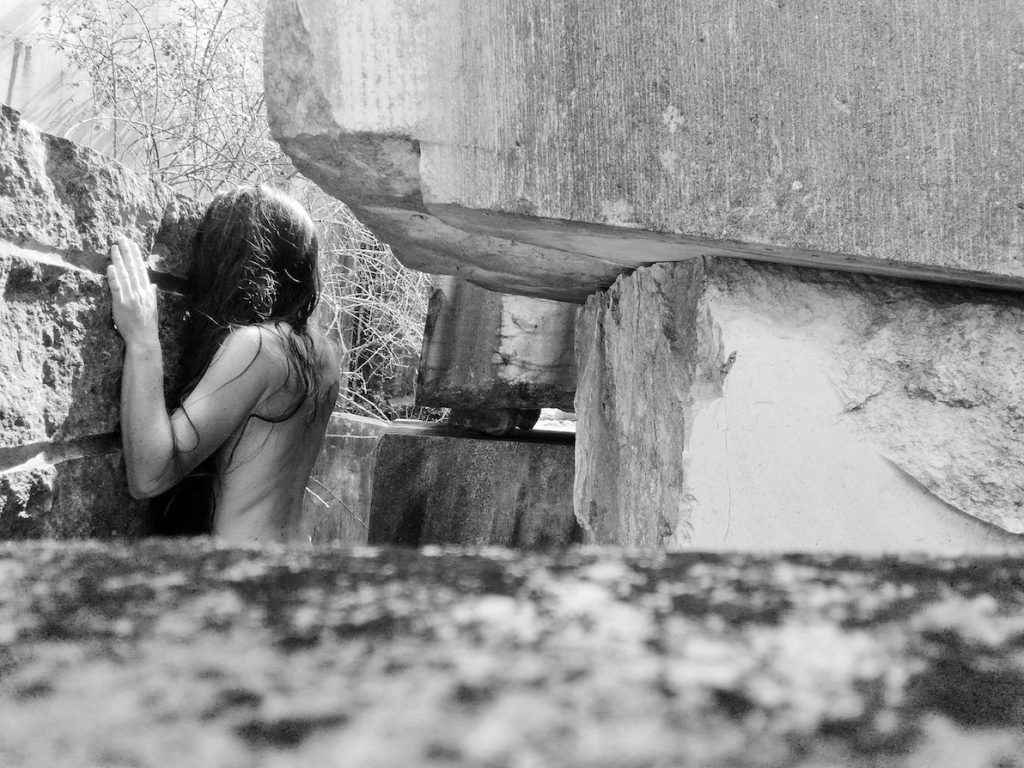Petra Kapš - OR poiesis, KISETSU quarry performance, photo detail #1, 2019
Yes, art comes along again. And thinks about the world: Works by Petra Kapš, Gertrude Moser-Wagner, Alfred Graf, Kurt Spitaler & Pouya Gourabi / kunstGarten  &  StreetGallery
The exhibition deals with people’s lives. Their expectations, hopes. Their relationship to the world around them.
After more than a year of the pandemic, which lies in wait for all of us as a dangerous burden, the question arises as to how far our empathy actually reaches?
Those who are provided for – such as salaried employees and pensioners – at least have a chance of financial survival, some probably even have plenty, others are facing the end, nothingness, the end. We can hardly talk about human dignity and human rights any more.
Nevertheless, everything is made dependent on the economy. Countless ailing companies were supported. Bankruptcies declined in 2020, even though trade was largely at a standstill!
Deferred rent debts are now leading to housing evictions: Where will the families move?
We were never locked up!
Anyone who says that should live in Moria!
Everyone could go outside at any time, if their job allowed it.
As a loner or in combination with other members of a shared flat.
There is a lot to see and hear everywhere, if you look, listen and are curious. It’s a good opportunity to get to grips with it.
This is sometimes popular, it happens. The questioned and unquestioned are presented in the media, also in the social network.
We learn horrible things and yet there are many who turn away and shut down. Also among politicians.
Few have the guts to ask for forgiveness for mistakes like the German chancellor.
But it’s about taking a break from the daily grind. To question whether it is time to think differently, to think anew. To find positive approaches to life and, if they have already been found, to expand them.
And if that means eating less meat from enslaved livestock, less snacking on egg powder from chicken concentration camps.
Or researching which plant, which animal lives next to us. Or to think about why many people are so grumpy, unhappy, cheeky, mean and mendacious?
Some laugh maliciously about an obligation to wear masks for the common good, make condescending remarks about Greta Thunberg, but that’s when art comes along and, together with Fridays for Future, offers against it: Mathis Huber be praised. In his Recreation series, he has set up a tribute to Greta Thunberg.
Yes, art comes along. And thinks about the world. In Graz, too, in many places; right now, in all of Styria!
At kunstGarten we’ve been on this track for ages and we’re really looking forward to it.
Getting to the bottom of it.
What do the earth, the glaciers, the last fire salamander say?
Does the general reflection only begin when the water is up to our mouths and drinking water has to be bought expensively?
Water that is now being washed down every day, even though the skin doesn’t like it at all. Despite ointments and lotions.
Only an early death can save us from old age. Otherwise it shows what we have experienced. And there are so many things to experience.
Lena Feitl conveys the beauty of wabi-sabi. Petra Kapš transforms mystical emphasis into realism, Gertrude Moser-Wagner entices the ears to listen to the voice of the earth to enable us to contribute to the healing of abuses committed.
Alfred Graf is concerned with processes in nature. He is very fond of river landscapes. Starting from the Archduke Johann Fountain on the Mur, Enns, Drau and Sann, he collected sediments and condensed them into river goddesses.
With the installation kollektiv//8, Kurt Spitaler takes up the theme of togetherness: I becomes we… individuals become a group; symbolised by ordinary buckets on iron bars, connected to each other by ropes.
Pouya Gourabi shows us the surrealistic rehearsal routine for an actor,
the absurdity to which people submit in order to survive.
So which direction do we take? A collectively meaningful one that represents a dignified life for the inhabitants of the earth, or are we sitting on the train of abundance in the delusion of a short-sighted happiness on a straight path to the ultimate goal: the extinction of all life?
Lena Feitl will provide a work for the Street Gallery in addition to graphic works. The young artist lives and works in Vienna and Styria. She wants to show essential things that are constantly around us and often overlooked by us. She studies at the Angewandte in Vienna, where she has already completed a degree in textile design with distinction.
What remains is what is and always has been there, a neutral construct , which connects everything.
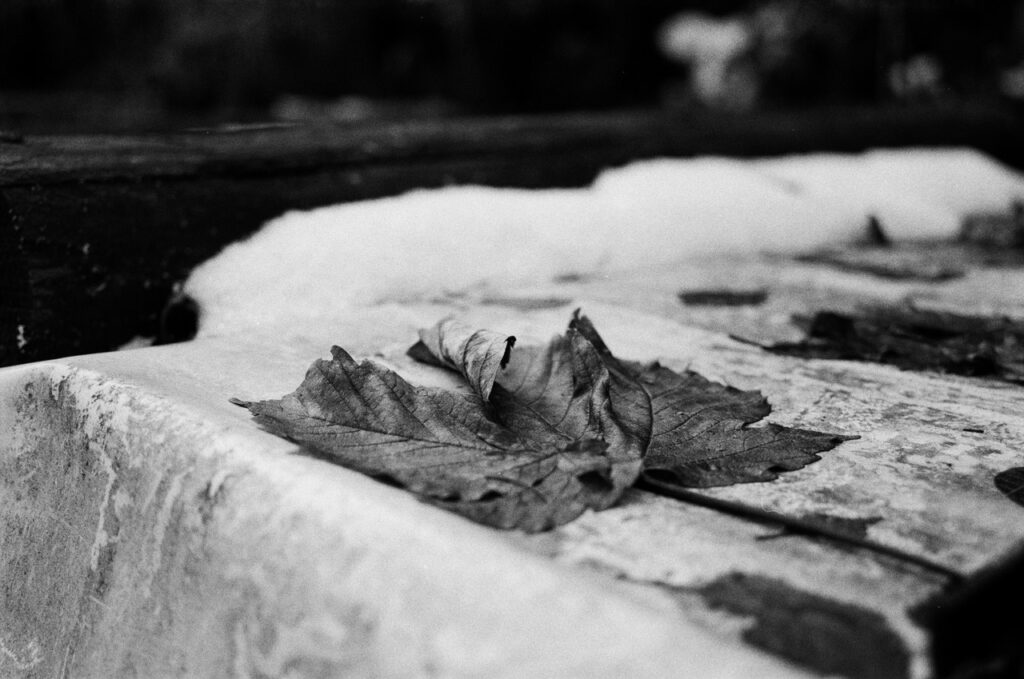
Lena Feitl: BARE, 2020 (35mm Film, SW)
Petra Kapš (alias OR poiesis, 1975, Slovenia) is an artist, writer, curator, working as freelance author. in
In the field of sound, radio, book art and performative practices she works under the name of OR poiesis. She waves her work in between sound art, radio, poetry sonor, books, performance.
Word, her core medium, she extends with sonic spheres of chrono-spatial poetry. She develops specific artistic practice poetry sonor, practicing live oration, performative field recording, poetic performance, acoustic and ambience explorations, radio, she is interested in aural memory and deep time of the body. Incorporating syntemporal presence through digital spheres she researches possibilities of intimate radio and is concerned with void ear of internet listener. Her sound/radio/book works are located solitudes. Homepage: www.orpoiesis.blogspot.com
Stones connects the human with the ancient, authentic, cosmic elements of the world. The intent is to amplify the vibrational qualities of the stone, transfer them into the human hearing range and integrate them as an interactive sound-frequency field that resonates with a listener’s body and consciousness. The artist is interested in the behavior of different material and biomorphic fields as well as their interference.Homepage: www.orpoiesis.blogspot.com
Gertrude Moser-Wagner, born at St.Georgen/Murau in Styria, Austria, in 1953Â lives and works in Vienna as a free-lance artist.
1977/78 Started studying sculpture with Prof. Wander Bertoni at the University of Applied Arts, Vienna. Continued studies at the Academy of Fine Arts, Vienna, with Prof. Bruno Gironcoli, diploma 1981.Gertrude Moser-Wagner Born in St. Georgen ob Murau. Studied sculpture in Vienna with Bruno Gironcoli, graduating in 1981, Academy of Fine Arts Vienna, after which she received teaching assignments there and at various art universities, until 2010. Fields of work: Project art, poetic intervention, installation, radio art, performance, video. Invitations to international projects, exhibitions, festivals. Since 2000 she has also been an editor, artist curator, founder. Organiser of interdisciplinary symposia, often with natural sciences, in the context of her own art processes. 
Ongoing projects: art goes science (since 2009). art contains (since 2015) in St. Georgen am Kreischberg, BienenVolkSchule St. Ruprecht. http://www.openscience4sustainability.at/person/gertrude-moser-wagner/
1988-2000 she formulated the so-called SOIL SAMPLE SERIES, carried out in (with) Prague, Bologna, Göttingen. The earth on which our feet stand is above all a process. This material earth is perceived biopolitically, as the soil made productive for (subsidised) monocultures or as contested territory for the settlement of more shopping centres. This is slowly changing, in the wake of the climate crisis, also through the media. We named and illustrated this soil life in many ways in the final project SOIL=Boden, Erde (in the Natural History Museum Vienna, HG Moser-Wagner, Triton Vienna 2002).
 
”HINEINHĂ–REN INSNERE (a meeting under shrubs)” – suggests that the soil sounds and yes – in fact a cosmos of animal and plant organisms communicate in it. Fungi form rhizomes and the roots virtually lead a life of their own. We hear it more and more often and get to see amazing images from inside the earth through the media.
In her work for the kunstGarten, this listening into the belly of the earth is illustrated by ear trumpets that used to be used medicinally. These eight form a group standing together on the ground, by the bushes. They suggest something like a meeting, a collegial gathering.
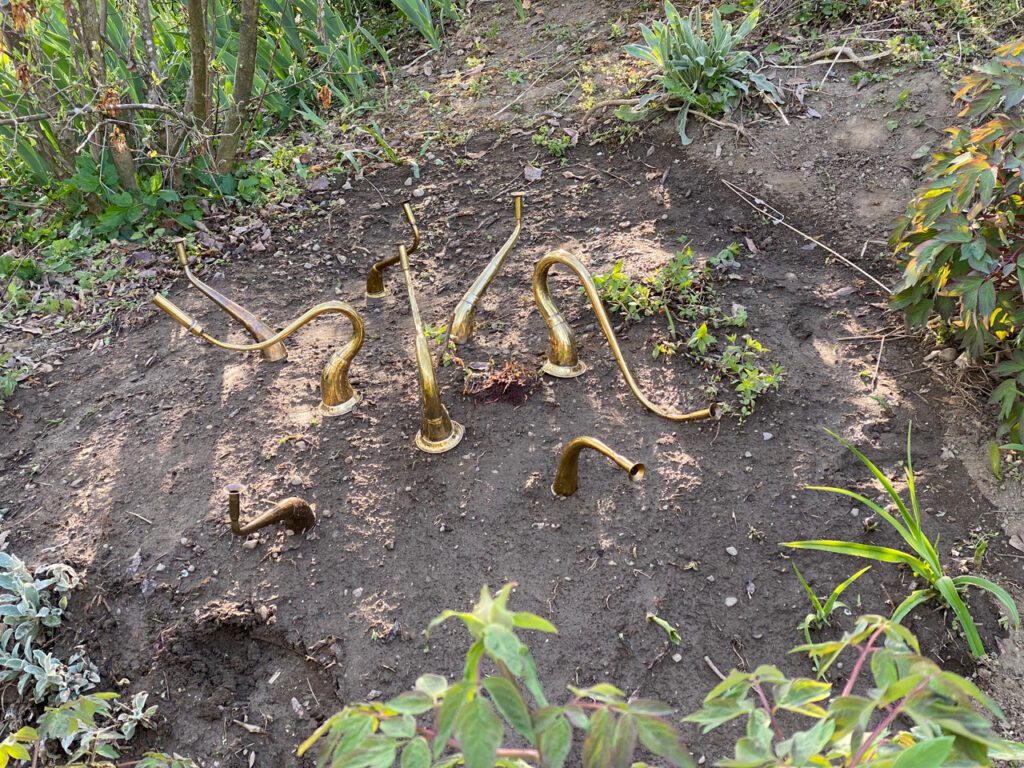
Gertrude Moser-Wagner HINEINHĂ–REN, Installation 2021
Pouya Gourabi was born during the Iranian revolution and grew up during wartime. His love for films started during those days when he saw ‘The Third Man’ by Carol Reed and at a young age he was struck by films. When Pouya started to show more love for films, little by little, he saw and learned about the New Hollywood films and the World Cinema, from Kurosawa to Kubrick¬.
Fast-forwarding his life from the early 1990s when he emigrated to the Netherlands, to studying filmmaking at the Art Academy, to working on short films, underground films, art films, and commercials in the Netherlands, Serbia, USA, Iran, Italy and Kuwait.
Director Statement:
The idea to make the low-budget film THE SECOND AUDITION was to create a zeitgeist about the life and times in the Hague area in the Netherlands: to make a film about the almost-surreal circumstances and to represent these in a realistic mood.
Being inspired by the revisionist detective films of the 1970’s and their usage of the classical hardboiled elements helped me write the story.
Watching a lot of autonomous first feature films also helped me to identify the genres of the story in order to use each shooting day with a different team of actors, because of the tight schedule and budget limitations. THE SECOND AUDITION is an independent art film, a midnight movie that tends towards the social satire genre. With soundtrack by the Electro music pioneer Legowelt, the story forces the main unemployed actor David Geysen to move thorough the streets for a private job.
THE SECOND AUDITION is somehow an international production with Belgian, Dutch, Iranian, Pakistani and Somalian actors. Shahin Khakpour at Studio Moon in Tehran, Iran did the sound editing and the final mix, everything online.
Short Synopsis: An unemployed actor returns to his old theatre company to do an audition with his colleague, for a play that they have performed many times before. Under the direction of the newly named artistic director the actor is asked to try out a mask, which he refuses. After a heated argument the actor leaves the scene. In the dressing room his colleague gives him a telephone number for a private job…
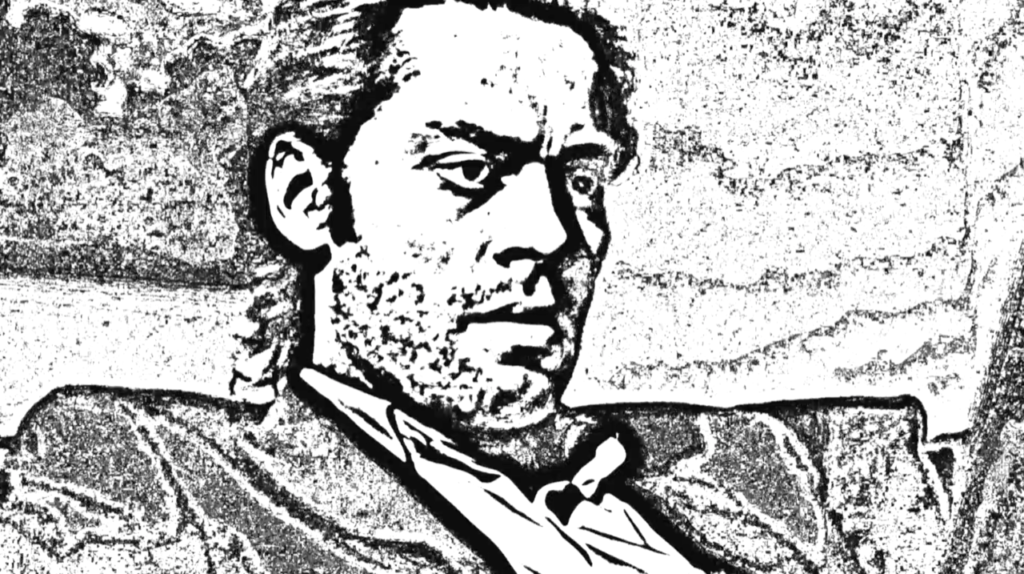
Poya Gourabi THE SECOND AUDITION, Film Still
Alfred Graf, Â born in Feldkirch in 1958, studied at the Academy of Fine Arts in Vienna, has been exploring the sediments and rock formations of landscapes in all parts of the world for years – from his native Vorarlberg to the US state of Kentucky, the island of Sylt or Mount Vesuvius.
On extensive tours, he collects various soils, sands and rocks at the respective location, which he crushes in the studio, binds with wax – which comes from the same region as the geological materials – and fixes on cotton molino according to different creative concepts. In addition to paintings, Alfred Graf also creates three-dimensional objects such as cubes and cuboids, which he shapes by successively layering the materials.
The artist depicts landscapes in an abstract way in terms of their texture, their inner structure and the colours that shape them and give them their own character. This is how works are created in which Alfred Graf allows the essence of a region to express itself, as it were.
born 1966 in Bruck/Mur, grew up in Judenburg (Stmk) and GroĂźbuch (Ktn),
studied sociology (1991 diploma with distinction) and sculpture at the Academy of Fine Arts with
with Bruno Gironcoli (1999 diploma with distinction). He lives in Vienna and works in Kottingbrunn (Lower Austria).
Already during his studies Kurt Spitaler developed the form of connection or sewing that is characteristic for his works. The principle of serial addition determines the concise effect of his works of art, which are mostly reduced to simple basic forms. The connection has not only an aesthetic, but also an elementary functional significance by combining individual elements of the everyday world into a new whole.
Memberships
KĂĽnstlerhaus Wien
Kunstverein Baden
IG-Bildende Kunst
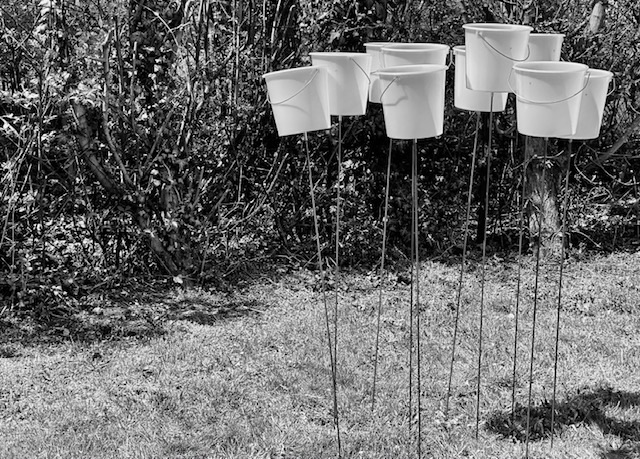
Kurt Spitaler kollektiv//10 2021 Kübel, Eisen, variable Größe

